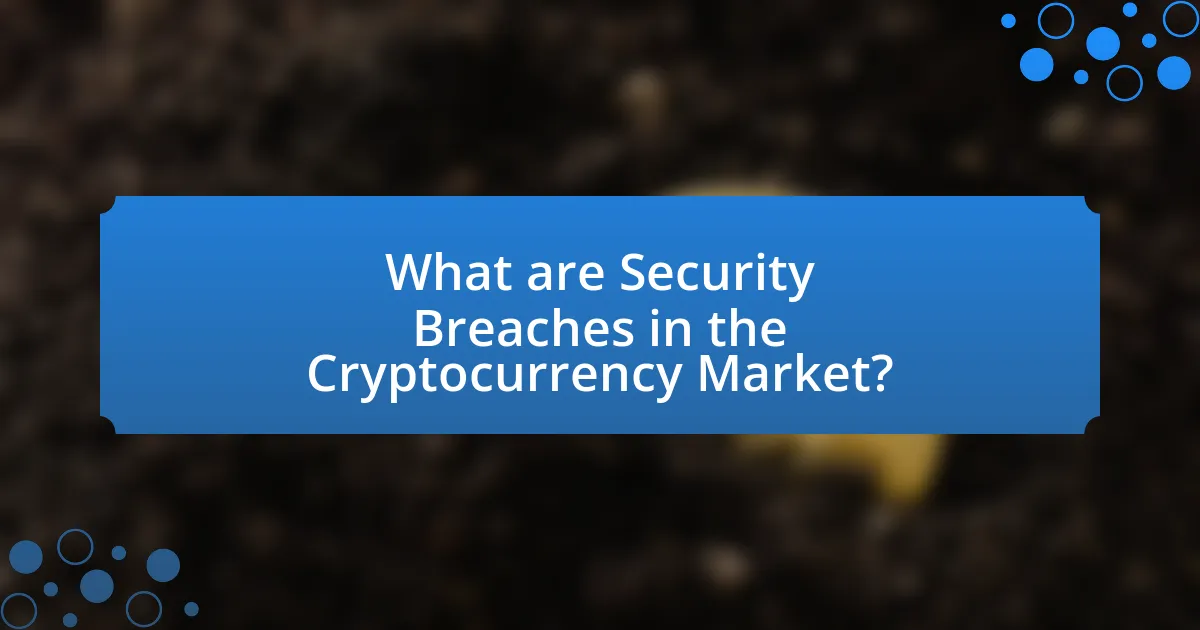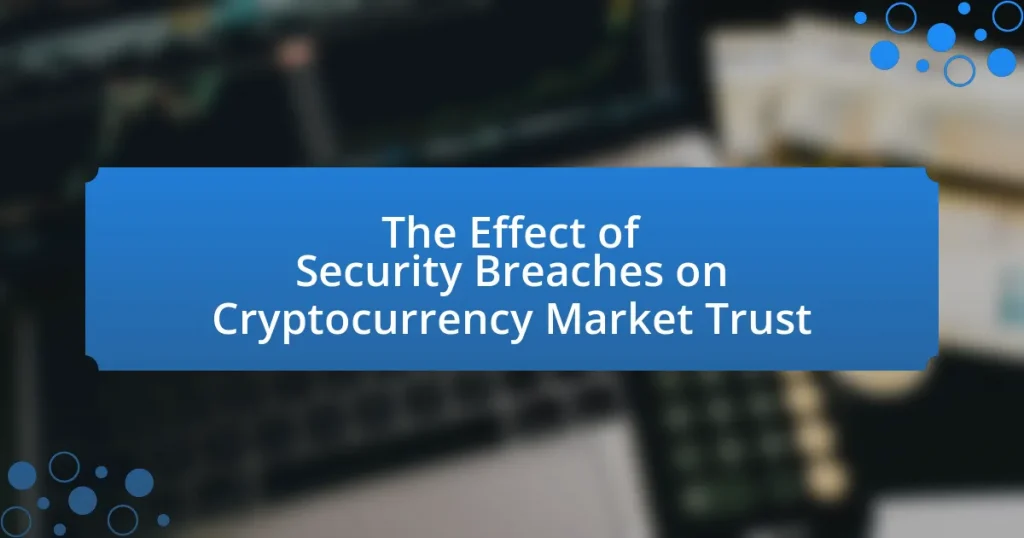Security breaches in the cryptocurrency market refer to unauthorized access or attacks on exchanges, wallets, or networks that compromise digital assets. These breaches can lead to significant financial losses, loss of user data, and a decline in market trust, as evidenced by incidents like the Mt. Gox hack. The article explores how security breaches occur, the methods used by hackers, and the differences between internal and external threats. It also discusses the consequences of breaches for cryptocurrency platforms, including legal implications and the impact on user confidence and market stability. Strategies for mitigating these risks, enhancing security measures, and the role of regulatory frameworks in restoring trust are also examined.

What are Security Breaches in the Cryptocurrency Market?
Security breaches in the cryptocurrency market refer to unauthorized access or attacks on cryptocurrency exchanges, wallets, or networks that compromise the security of digital assets. These breaches can result in the theft of funds, loss of user data, and erosion of trust in the cryptocurrency ecosystem. For instance, the 2014 Mt. Gox hack led to the loss of approximately 850,000 Bitcoins, significantly impacting market confidence and regulatory scrutiny. Such incidents highlight vulnerabilities in the infrastructure of cryptocurrency platforms, underscoring the need for enhanced security measures to protect users and maintain market integrity.
How do security breaches occur in cryptocurrency exchanges?
Security breaches in cryptocurrency exchanges occur primarily due to vulnerabilities in their software, inadequate security protocols, and human error. These exchanges often face attacks such as hacking, phishing, and insider threats, which exploit weaknesses in their systems. For instance, the 2014 Mt. Gox hack, where approximately 850,000 Bitcoins were stolen, exemplifies how inadequate security measures can lead to significant breaches. Additionally, according to a report by CipherTrace, cryptocurrency exchanges lost over $1.9 billion to hacks and fraud in 2020 alone, highlighting the ongoing risks associated with these platforms.
What are the common methods used by hackers to exploit vulnerabilities?
Hackers commonly exploit vulnerabilities through methods such as phishing, malware, SQL injection, and denial-of-service attacks. Phishing involves tricking individuals into revealing sensitive information by masquerading as a trustworthy entity, often through emails or fake websites. Malware, including viruses and ransomware, is used to infiltrate systems and steal or encrypt data. SQL injection targets databases by inserting malicious SQL queries, allowing unauthorized access to sensitive data. Denial-of-service attacks overwhelm systems with traffic, rendering them inoperable. These methods are well-documented in cybersecurity literature, highlighting their prevalence and effectiveness in compromising security.
How do internal and external threats differ in their impact on security?
Internal threats typically originate from within an organization, such as employees or contractors, and can lead to significant security breaches due to insider knowledge and access. In contrast, external threats come from outside the organization, including hackers and cybercriminals, and often exploit vulnerabilities in systems or networks. Internal threats can result in data leaks or sabotage, while external threats may lead to unauthorized access or theft of sensitive information. According to a report by the Ponemon Institute, internal threats account for 60% of data breaches, highlighting their substantial impact on security compared to external threats, which, while also damaging, are often mitigated by perimeter defenses.
What are the consequences of security breaches for cryptocurrency platforms?
Security breaches for cryptocurrency platforms lead to significant financial losses, reputational damage, and regulatory scrutiny. Financial losses occur due to theft of funds, with notable incidents like the Mt. Gox hack in 2014 resulting in the loss of approximately $450 million. Reputational damage follows, as users lose trust in the platform’s ability to secure their assets, leading to decreased user engagement and potential withdrawal of funds. Regulatory scrutiny increases as governments may impose stricter regulations or penalties on platforms that fail to protect user data and funds, exemplified by the increased oversight seen after breaches like the Coincheck hack in 2018, which resulted in a loss of $530 million. These consequences collectively undermine market trust in cryptocurrency platforms, affecting their long-term viability.
How do breaches affect user data and funds?
Breaches compromise user data and funds by exposing sensitive information and enabling unauthorized transactions. When a security breach occurs, hackers can access personal details such as passwords, financial information, and identification data, leading to identity theft and financial loss. For instance, the 2014 breach of Mt. Gox resulted in the loss of approximately 850,000 Bitcoins, valued at around $450 million at the time, severely impacting user trust in cryptocurrency exchanges. Additionally, breaches can lead to regulatory scrutiny and increased security measures, further affecting market dynamics and user confidence.
What legal implications arise from security breaches in the cryptocurrency sector?
Security breaches in the cryptocurrency sector can lead to significant legal implications, including regulatory scrutiny, liability for damages, and potential criminal charges. Regulatory bodies, such as the SEC in the United States, may impose fines and sanctions on companies that fail to protect user data adequately, as seen in cases like the 2016 Bitfinex hack, where the exchange faced legal challenges due to inadequate security measures. Additionally, affected users may pursue class-action lawsuits against companies for negligence, as demonstrated by the 2018 Coincheck hack, which resulted in legal actions from investors seeking compensation for their losses. Furthermore, breaches can trigger compliance issues with laws such as the General Data Protection Regulation (GDPR) in Europe, which mandates strict data protection protocols. These legal consequences underscore the importance of robust security measures in maintaining trust within the cryptocurrency market.

How do Security Breaches Impact Market Trust?
Security breaches significantly undermine market trust by eroding consumer confidence and leading to financial losses. When a security breach occurs, it often results in sensitive data exposure, which can cause customers to question the reliability and safety of the affected platform. For instance, the 2014 Mt. Gox hack, where approximately 850,000 Bitcoins were stolen, led to a dramatic decline in user trust and a subsequent drop in Bitcoin’s market value by over 80%. This illustrates how breaches can create a ripple effect, causing users to withdraw their investments and seek safer alternatives, thereby destabilizing the entire market.
Why is trust crucial in the cryptocurrency market?
Trust is crucial in the cryptocurrency market because it underpins the willingness of individuals and institutions to engage in transactions and investments. Without trust, participants are less likely to invest or use cryptocurrencies, as they fear potential fraud, volatility, and security breaches. For instance, a 2021 survey by the Cambridge Centre for Alternative Finance found that 70% of cryptocurrency users cited trust in the technology and its security as a primary reason for their participation. This highlights that trust directly influences market stability and growth, as a lack of it can lead to decreased adoption and increased market volatility.
How does user confidence influence market stability?
User confidence significantly influences market stability by directly affecting trading behavior and investment decisions. When users have high confidence in a market, they are more likely to invest and trade actively, which can lead to increased liquidity and price stability. Conversely, low user confidence, often triggered by events such as security breaches, can result in panic selling and reduced participation, leading to heightened volatility and instability. For instance, after the 2014 Mt. Gox hack, user confidence plummeted, causing Bitcoin’s price to drop from around $800 to approximately $400 within weeks, illustrating how diminished trust can destabilize a market.
What role does reputation play in the success of cryptocurrency platforms?
Reputation is critical to the success of cryptocurrency platforms as it directly influences user trust and adoption. A strong reputation fosters confidence among potential users, leading to increased participation and investment. For instance, platforms like Coinbase and Binance have established robust reputations through consistent security measures and transparent operations, resulting in millions of active users and significant market capitalization. Conversely, platforms that experience security breaches, such as Mt. Gox, suffer reputational damage, leading to user attrition and loss of market share. This correlation between reputation and user trust underscores the importance of maintaining a positive image in the competitive cryptocurrency landscape.
What evidence exists linking security breaches to decreased market trust?
Security breaches are linked to decreased market trust, as evidenced by multiple studies showing a direct correlation between incidents of data breaches and declines in consumer confidence. For instance, a study by Ponemon Institute found that 63% of consumers would stop purchasing from a company after a data breach, indicating a significant loss of trust. Additionally, research published in the Journal of Cybersecurity reveals that companies experiencing security breaches often see a drop in stock prices, with an average decline of 7.27% within a week of the breach announcement. This data illustrates that security breaches not only impact immediate consumer behavior but also have lasting effects on market perception and trustworthiness.
How have past breaches affected user behavior and investment decisions?
Past breaches have significantly diminished user trust and altered investment decisions in the cryptocurrency market. For instance, following the 2014 Mt. Gox hack, which resulted in the loss of approximately 850,000 Bitcoins, user confidence plummeted, leading to a 36% drop in Bitcoin’s price within a week. This incident prompted many investors to withdraw their funds and adopt a more cautious approach towards cryptocurrency investments. Additionally, a 2020 study by Chainalysis indicated that security breaches led to a 20% decrease in new user registrations on affected platforms, showcasing a direct correlation between breaches and user behavior. Such historical events illustrate how breaches not only impact immediate market dynamics but also shape long-term investment strategies and user engagement in the cryptocurrency sector.
What trends can be observed in market reactions following security incidents?
Market reactions following security incidents typically exhibit a trend of immediate negative impact on cryptocurrency prices, often leading to significant sell-offs. For instance, after the 2016 Bitfinex hack, Bitcoin’s price dropped by approximately 20% within days. Additionally, market volatility tends to increase, with trading volumes spiking as investors react to the news. Research by the Cambridge Centre for Alternative Finance indicates that security breaches can lead to a long-term decline in market trust, resulting in reduced investor participation and lower overall market capitalization. This pattern highlights the critical relationship between security incidents and market sentiment in the cryptocurrency sector.

What Strategies Can Mitigate the Effects of Security Breaches?
Implementing robust security protocols, conducting regular audits, and enhancing user education are effective strategies to mitigate the effects of security breaches. Organizations can adopt multi-factor authentication and encryption to protect sensitive data, which reduces the likelihood of unauthorized access. Regular security audits help identify vulnerabilities, allowing for timely remediation. Furthermore, educating users about phishing attacks and safe online practices empowers them to recognize and avoid potential threats. According to a report by IBM, organizations that implement comprehensive security measures can reduce the average cost of a data breach by as much as $1.2 million.
How can cryptocurrency exchanges enhance their security measures?
Cryptocurrency exchanges can enhance their security measures by implementing multi-factor authentication (MFA) for user accounts. MFA significantly reduces the risk of unauthorized access, as it requires users to provide two or more verification factors to gain access. According to a report by the Cybersecurity & Infrastructure Security Agency (CISA), MFA can prevent 99.9% of automated attacks, demonstrating its effectiveness in securing accounts against breaches. Additionally, exchanges should employ cold storage for the majority of their digital assets, which involves keeping funds offline to protect them from online threats. A study by Chainalysis found that exchanges using cold storage experienced fewer successful hacks compared to those that kept most assets online. Regular security audits and penetration testing can also identify vulnerabilities, allowing exchanges to address potential weaknesses proactively. By adopting these measures, cryptocurrency exchanges can significantly bolster their security posture and maintain user trust.
What best practices should be implemented to prevent breaches?
To prevent breaches, organizations should implement multi-factor authentication (MFA) as a primary security measure. MFA significantly reduces the risk of unauthorized access by requiring users to provide two or more verification factors, making it harder for attackers to compromise accounts. According to a 2020 report by the Cybersecurity & Infrastructure Security Agency (CISA), implementing MFA can block over 99% of automated attacks. Additionally, regular software updates and patch management are crucial, as they address vulnerabilities that could be exploited by attackers. The National Institute of Standards and Technology (NIST) emphasizes that timely updates are essential for maintaining system integrity. Furthermore, conducting regular security training for employees helps to raise awareness about phishing and social engineering tactics, which are common methods used to breach security. The 2021 Verizon Data Breach Investigations Report highlights that human error is a factor in 85% of breaches, underscoring the importance of training. Lastly, organizations should establish a robust incident response plan to quickly address any breaches that do occur, minimizing damage and restoring trust.
How can user education contribute to overall security in the market?
User education significantly enhances overall security in the market by equipping individuals with the knowledge to recognize and mitigate risks associated with security breaches. Educated users are more likely to adopt best practices, such as using strong passwords and enabling two-factor authentication, which can reduce the likelihood of unauthorized access to their accounts. Research indicates that organizations with comprehensive security awareness programs can reduce the risk of security incidents by up to 70%, demonstrating the effectiveness of user education in fostering a more secure environment.
What role do regulatory frameworks play in restoring market trust?
Regulatory frameworks play a crucial role in restoring market trust by establishing clear guidelines and standards that enhance transparency and accountability within the cryptocurrency market. These frameworks help mitigate risks associated with security breaches by enforcing compliance measures that protect investors and consumers. For instance, regulations such as the European Union’s Markets in Crypto-Assets (MiCA) proposal aim to create a unified regulatory environment, which can reduce uncertainty and foster confidence among market participants. Historical data shows that markets with robust regulatory oversight tend to recover more quickly from crises, as seen in traditional finance during the 2008 financial crisis, where regulatory reforms helped restore investor confidence.
How can compliance with regulations improve user confidence?
Compliance with regulations enhances user confidence by ensuring that businesses adhere to established standards for security and transparency. When companies follow regulations, they demonstrate a commitment to protecting user data and maintaining ethical practices, which fosters trust. For instance, a study by the Cambridge Centre for Alternative Finance found that regulatory compliance in the cryptocurrency sector can lead to increased user adoption and investment, as users feel more secure knowing that their transactions are governed by legal frameworks. This assurance reduces perceived risks associated with security breaches, ultimately strengthening user confidence in the market.
What are the challenges in enforcing security regulations in the cryptocurrency space?
Enforcing security regulations in the cryptocurrency space faces significant challenges due to the decentralized nature of cryptocurrencies, which complicates regulatory oversight. The anonymity of transactions and users makes it difficult for regulators to trace illicit activities, leading to a lack of accountability. Additionally, the rapid evolution of technology and the emergence of new cryptocurrencies outpace existing regulatory frameworks, leaving gaps in enforcement. For instance, the Financial Action Task Force (FATF) has noted that many jurisdictions struggle to implement effective anti-money laundering (AML) measures specific to cryptocurrencies. Furthermore, the global nature of cryptocurrency transactions creates jurisdictional issues, as different countries have varying regulations, making it hard to enforce consistent security standards.
What steps can users take to protect themselves in the cryptocurrency market?
Users can protect themselves in the cryptocurrency market by implementing strong security measures, such as using hardware wallets, enabling two-factor authentication, and conducting thorough research on exchanges and projects. Hardware wallets, which store private keys offline, significantly reduce the risk of hacking, as evidenced by the fact that over 90% of cryptocurrency thefts occur on exchanges rather than in cold storage. Enabling two-factor authentication adds an additional layer of security, making unauthorized access more difficult. Furthermore, users should verify the legitimacy of exchanges and projects by checking for regulatory compliance and user reviews, as a study by Chainalysis found that 95% of scams are linked to unregulated platforms.


